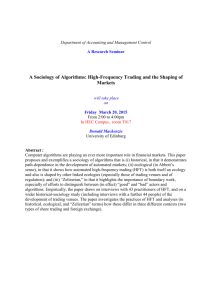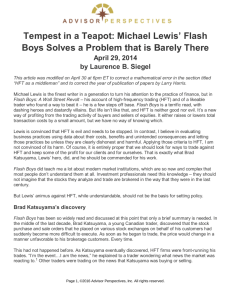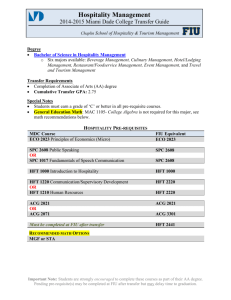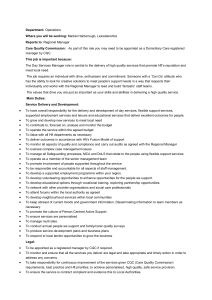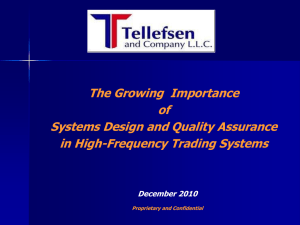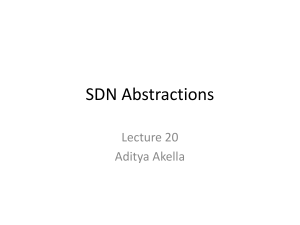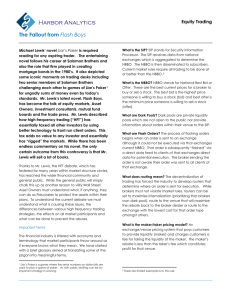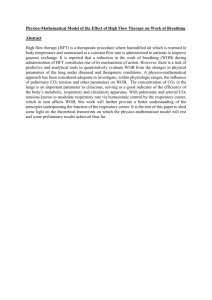InvestLit Summary of ABCs of Hedge Funds: Alphas, Betas, and Costs
advertisement
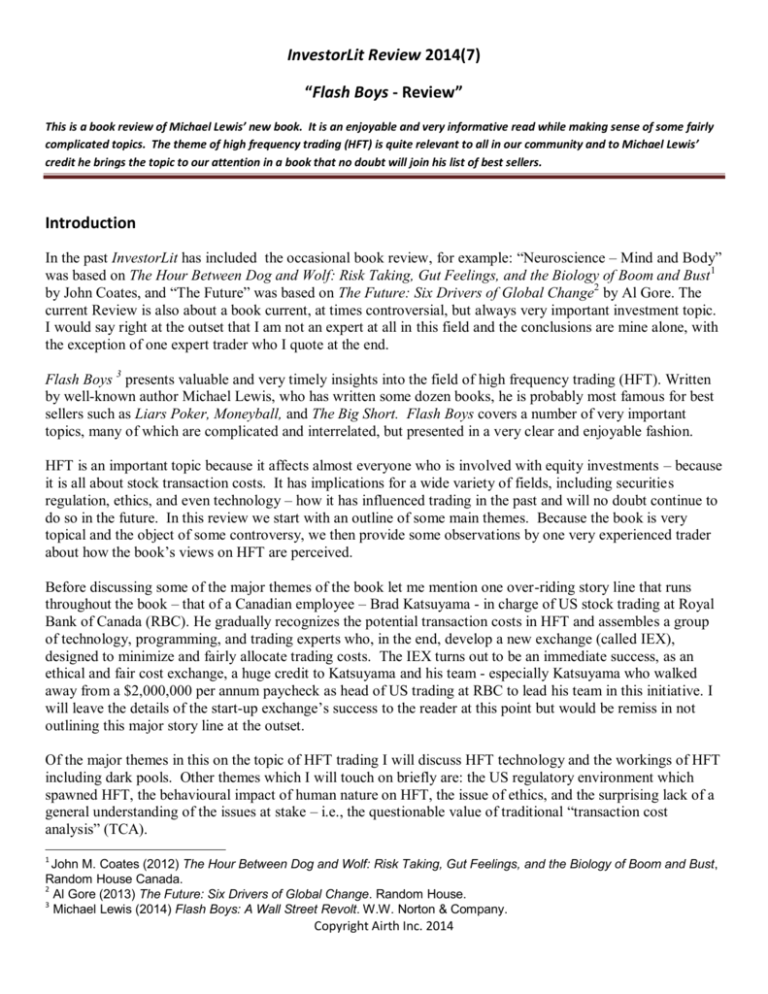
InvestorLit Review 2014(7) “Flash Boys - Review” This is a book review of Michael Lewis’ new book. It is an enjoyable and very informative read while making sense of some fairly complicated topics. The theme of high frequency trading (HFT) is quite relevant to all in our community and to Michael Lewis’ credit he brings the topic to our attention in a book that no doubt will join his list of best sellers. Introduction In the past InvestorLit has included the occasional book review, for example: “Neuroscience – Mind and Body” was based on The Hour Between Dog and Wolf: Risk Taking, Gut Feelings, and the Biology of Boom and Bust1 by John Coates, and “The Future” was based on The Future: Six Drivers of Global Change2 by Al Gore. The current Review is also about a book current, at times controversial, but always very important investment topic. I would say right at the outset that I am not an expert at all in this field and the conclusions are mine alone, with the exception of one expert trader who I quote at the end. Flash Boys 3 presents valuable and very timely insights into the field of high frequency trading (HFT). Written by well-known author Michael Lewis, who has written some dozen books, he is probably most famous for best sellers such as Liars Poker, Moneyball, and The Big Short. Flash Boys covers a number of very important topics, many of which are complicated and interrelated, but presented in a very clear and enjoyable fashion. HFT is an important topic because it affects almost everyone who is involved with equity investments – because it is all about stock transaction costs. It has implications for a wide variety of fields, including securities regulation, ethics, and even technology – how it has influenced trading in the past and will no doubt continue to do so in the future. In this review we start with an outline of some main themes. Because the book is very topical and the object of some controversy, we then provide some observations by one very experienced trader about how the book’s views on HFT are perceived. Before discussing some of the major themes of the book let me mention one over-riding story line that runs throughout the book – that of a Canadian employee – Brad Katsuyama - in charge of US stock trading at Royal Bank of Canada (RBC). He gradually recognizes the potential transaction costs in HFT and assembles a group of technology, programming, and trading experts who, in the end, develop a new exchange (called IEX), designed to minimize and fairly allocate trading costs. The IEX turns out to be an immediate success, as an ethical and fair cost exchange, a huge credit to Katsuyama and his team - especially Katsuyama who walked away from a $2,000,000 per annum paycheck as head of US trading at RBC to lead his team in this initiative. I will leave the details of the start-up exchange’s success to the reader at this point but would be remiss in not outlining this major story line at the outset. Of the major themes in this on the topic of HFT trading I will discuss HFT technology and the workings of HFT including dark pools. Other themes which I will touch on briefly are: the US regulatory environment which spawned HFT, the behavioural impact of human nature on HFT, the issue of ethics, and the surprising lack of a general understanding of the issues at stake – i.e., the questionable value of traditional “transaction cost analysis” (TCA). 1 John M. Coates (2012) The Hour Between Dog and Wolf: Risk Taking, Gut Feelings, and the Biology of Boom and Bust, Random House Canada. 2 Al Gore (2013) The Future: Six Drivers of Global Change. Random House. 3 Michael Lewis (2014) Flash Boys: A Wall Street Revolt. W.W. Norton & Company. Copyright Airth Inc. 2014 The technology underlying HFT is a theme which runs throughout the book, beginning with the first and ending with the last chapter. The first chapter describes a well-kept secret of construction in 2010 of an almost straight line glass fibre optic buried cable running from the Chicago Mercantile Exchange’s data centre to New Jersey’s NASDAQ data centre. It was built to replace a slower system in use pre-2007. The last chapter describes another replacement system finished in 2013; a microwave transmission tower system again connecting similar points, although running over mountain tops and dependent only upon sight lines and reasonable weather. The whole purpose of this is outlined right at the start: speed of access to trading orders and exchange data is of the highest importance to HFT (as we explain in the second theme). Just to divert for a second – the reader will see these details throughout the book. Light travels at 186,000 miles per hour including through glass fibre optics cables, amounting to about 13 milliseconds between Chicago and New York. (A millisecond is one thousandths of a second and a blink of an eye is about 100 milliseconds). The pre-2007 the speed was about 17 milliseconds and the microwave system is much faster than both at about 8 milliseconds over the same distance. The reader, like I was, will probably be amazed at the speed of these transmissions but will see why they are so important and why changing technology will likely affect HFT and investing in general in the future. A second theme, much harder to explain, is the workings of HFT, including the operations of dark pools. The book describes the proliferation of exchanges in early 2000s as trading became more competitive. High frequency trading emerged in late 2000s as brokers recognized the profitability of timely data and execution of orders. HFT firms sprang up locating close to the above mentioned data centres with extremely high speed connections to these centres. Much of HFT success relies on constant electronic “pinging” (my word) the different exchanges with bids and offerings of small blocks of shares to discover supply and demand before others and then attempting to profitably arbitrage existing bids and offers on the various exchanges. Dark pools are trading vehicles mainly operated by major banks, which attempt to do the same thing. Their name comes from the fact that they are much closed to release of operational information especially to the public, but as much as possible to regulators – the purpose being to provide anonymity to clients. Dark pools allow access to HFTs for a fee. The book makes reference to some dark pool trades as not being the most efficient. Dark pools also need speed of access to trade data as HFTs do and the book has part of a chapter devoted to just how challenging this can be for a big organization. As mentioned, there are several other themes well-worth mentioning. One is the US financial regulatory environment. The book outlines both how it has changed over the 2000s, especially post-crash, and what its changes were intended to accomplish. Ironically the reaction of the markets and in particular HFT, while optically conforming to the changing regulatory environment, created greater transaction cost problems than before. The point being, the competitive and free enterprise environment in the US makes it very difficult for even the best intentioned financial regulation to be effective. This brings up a minor theme in the book, that of greed and the nature of human behavior. When profitable loopholes can be discovered, many will pour into that endeavor, at least until their behavior is regulated or the costs to the public are recognized and alternatives are found – the IEX for example. Related to this, the whole field of ethics is a theme throughout, certainly important, especially given its high status in our CFA constituency. Brad Katsuyama and his team, originators of IEX, deserve a lot of credit for their ethical pursuits. Finally, throughout the book, the point is made that clients are constantly told their trading activity is handled in their interests. The book makes the further point that it is the norm that clients do not see the true trading costs. Indeed, the book concludes that traditional TCA in this era of HFT is of questionable value. Since I am not an expert on HFT, I obtained the views of a very experienced trader (who remain nameless), but whom I have known for a long time and indeed worked with in my career in pension fund management, 2 specifically in the field of TCA. He and his team were involved with IEX and HFT right from the start and gave read all the nooks referred to in “Flash Boys”. Their views are as follows: HFT is not viewed by the regulators as illegal or they would have done something about it. Some practices of HFT benefit the market as a whole although some strategies are clearly intended to make money at the expense of the participants. Some concerns of this trader and his team include the aspect that arrangements provided by exchanges for HFT strategies leads to asymmetric advantages for HFTs over others in the legitimate process of natural liquidity. Also the proliferation of exchanges and dark pools contributes very little to liquidity, despite the frequent routing of trade orders to these venues. As well, the increasing complexity of the market and speed of some strategies increases systematic risk, a structural break in prices, and liquidity imbalances. Although fees and commissions have declined, block-size trades have become more difficult to execute without being detected – something that IEX has contributed to improving. Buy side firms should continuously review and evaluate transaction costs in this new and complex market environment. The IEX team is comprised of individuals with very deep knowledge in trading and technology, and through the book, have brought a very important topic to greater audience for discussion and hopefully action. Overall, I agree, Flash Boys is a very worthwhile contribution to our current understanding of HFT. The book is well-researched, well-written, and enjoyable to read and it addresses quite a range of topics and explains complex topics very well. I hope you enjoy the book and learn a lot from it, as I did. 3
